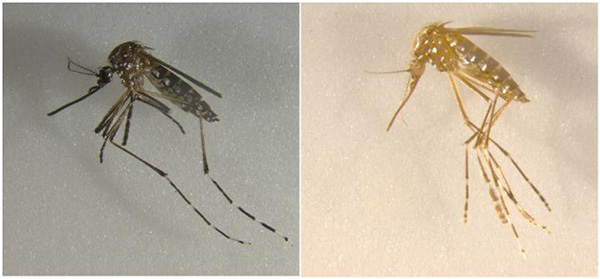Pathogenic arboviruses, including dengue, chikungunya, yellow fever, and Zika, are all spread by the mosquito Aedes aegypti. Researchers at the University of California, Riverside (UCR), have now developed transgenic strains of this mosquito that stably express the Cas9 enzyme in their germline, making CRISPR genome editing fast and efficient and opening up the potential to develop “gene drive” strategies for controlling mosquito populations in the wild.
As an initial proof of concept, the researchers, headed by Omar Akbari, Ph.D., an assistant professor of entomology in UCR's College of Natural and Agricultural Sciences, disrupted different genes in the Cas9-expressing mosquito embryos, which affected vision, flight, and blood feeding. “Overall, our results demonstrate that our simplified transgenic Cas9 system has improved capacity to rapidly induce highly efficient and specific targeted genome modifications, including gene disruptions, deletions, and insertions,” the researchers write in their published paper in the Proceedings of the National Academy of Sciences (PNAS) (“Germline Cas9 Expression Yields Highly Efficient Genome Engineering in a Major Worldwide Disease Vector, Aedes aegypti”).
The CRISPR/Cas9 system has been exploited for precision genome engineering in many different organisms. The technology uses short guide RNAs (sgRNAs) that bind to Cas9 and direct the enzyme to the specified DNA sequence, where double-stranded breaks are made.
There are a variety of methods for applying CRISPR-mediated genome engineering. Approaches based on directly injecting purified sgRNAs combined with either purified Cas9 RNA, recombinant Cas9 protein, or Cas9 expression plasmids have all been successful in a variety of organisms, including mosquitoes, the researchers point out. However, success rates vary, and previous attempts to use genome editing to prevent mosquitoes from spreading pathogens have been hampered by low mutation rates, poor survival rates of the transgenic insects, and inefficient transmission of disrupted genes to offspring.
An alterative approach is to generate transgenic organisms that stably express Cas9 in the germline. This method can reduce toxicity in embryos and increase both the rates of mutagenesis and the rates of germline transmission of the disrupted genes. Germline expression of Cas9 is also a prerequisite for the development of gene drive technologies, a strategy for controlling vector-borne diseases by spreading disruptive alleles through a population, the authors continue. It’s effectively a way of biasing gene inheritance in favor of self-destructive genes and could feasibly increase the likelihood that the genes are passed to offspring to 99% or 100% if a multiplexing approach is used.
“In mosquitoes, gene drives could potentially be used to rapidly disseminate a genetic payload that reduces pathogen transmission throughout a population, thereby suppressing vector competence and human disease transmission,” the team writes. “Other possible applications include the suppression of the population by spreading alleles that impair fertility or viability.”
While Cas9 has been used to develop homing-based gene drives in organisms including yeast, Drosophila fruit flies, and Anopheles mosquitoes, such a system hasn't previously been developed in Ae. aegypti. The researchers created six different Cas9-expressing strains of Ae. aegypti mosquito and tested the CRISPR editing technology in the transgenic embryos by disrupting genes that caused the insects to grow with an extra eye (triple eyes), an extra maxillary palp (triple maxillary palps), a nonfunctional curved proboscis, malformed wings, eye pigmentation deficiencies, and whole-animal cuticle color defects. “Importantly, to achieve highly specific and consistent genome modifications, we demonstrate that embryos from these Cas9 strains need only be injected with easy-to-make sgRNAs,” the researchers write.
They also found that if they simultaneously injected embryos with multiple sgRNAS targeting the same gene, they achieved higher mutagenesis rates and the capacity to make large deletions. And by coinjecting the embryos with three different sgRNAs, they could target multiple genes at the same time. “An appealing advantage of our Cas9 transgenic system is the ability to efficiently disrupt multiple genes simultaneously,” the team comments. This ability to rapidly multiplex gene knockouts will also help researchers gain new insights into the mosquito’s genome and functional gene networks.
“These Cas9 strains can be used to develop split-gene drives, which are a form of gene drive by which the Cas9 and the gRNAs are inserted at separate genomic loci and depend on each other for spread,” notes Dr. Akbari, who is also a member of the university's Institute for Integrative Genome Biology. “This is the safest way to develop and test gene drives in the laboratory to ensure no spread into the wild….Next steps should be undertaken to identify the regulatory sequences that can be used to express the gRNAs from the genome, and, once these sequences are identified, developing gene drives in the species should be turnkey.”


